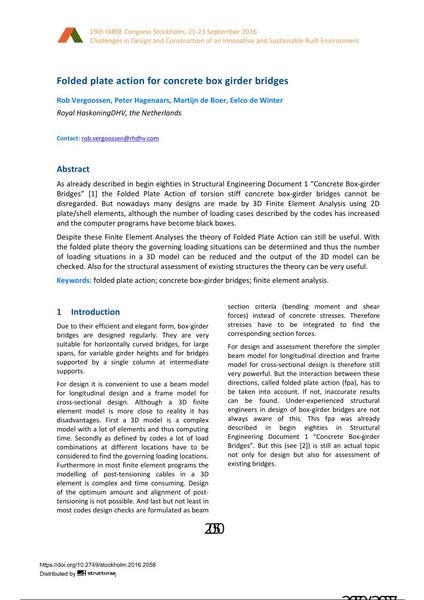Folded plate action for concrete box girder bridges

|
|
|||||||||||
Bibliographic Details
| Author(s): |
Rob Vergoossen
(Royal HaskoningDHV, the Netherlands)
Peter Hagenaars (Royal HaskoningDHV, the Netherlands) Eelco de Winter (Royal HaskoningDHV, the Netherlands) Martijn de Boer (Royal HaskoningDHV, the Netherlands) |
||||
|---|---|---|---|---|---|
| Medium: | conference paper | ||||
| Language(s): | English | ||||
| Conference: | IABSE Congress: Challenges in Design and Construction of an Innovative and Sustainable Built Environment, Stockholm, Sweden, 21-23 September 2016 | ||||
| Published in: | IABSE Congress Stockholm, 2016 | ||||
|
|||||
| Page(s): | 2050-2057 | ||||
| Total no. of pages: | 8 | ||||
| Year: | 2016 | ||||
| DOI: | 10.2749/stockholm.2016.2058 | ||||
| Abstract: |
As already described in begin eighties in Structural Engineering Document 1 “Concrete Box-girder Bridges” [1] the Folded Plate Action of torsion stiff concrete box-girder bridges cannot be disregarded. But nowadays many designs are made by 3D Finite Element Analysis using 2D plate/shell elements, although the number of loading cases described by the codes has increased and the computer programs have become black boxes. Despite these Finite Element Analyses the theory of Folded Plate Action can still be useful. With the folded plate theory the governing loading situations can be determined and thus the number of loading situations in a 3D model can be reduced and the output of the 3D model can be checked. Also for the structural assessment of existing structures the theory can be very useful. |
||||
| Keywords: |
finite element analysis FEA folded plate action concrete box-girder bridges
|
||||


